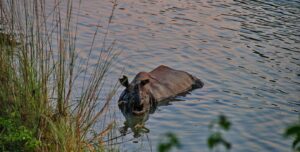Discover Raja Ampat, Indonesia's diving paradise in the Coral Triangle. Explore rich marine life, pristine waters and unique dive sites like Misool and Cape Kri.
GVI
Posted: July 10, 2024

Petrina Darrah
Posted: May 2, 2023
Nepal is a landlocked country situated in the Himalayas, bordered by India to the south and China to the north. This small nation is rich in cultural and natural heritage, including ten National Parks that offer stunning scenery and diverse wildlife. The National Parks of Nepal are a must-visit for any nature lover, offering a unique opportunity to experience the majestic Himalayan mountains and the abundant flora and fauna that call them home. In this article, we will take a closer look at the top five National Parks in Nepal.
Located in the Terai region of Nepal, Chitwan National Park is the country’s first National Park and the most popular. This park covers an area of 932 square kilometres and is home to more than 700 species of wildlife and plants. The park is known for its population of Bengal tigers, one-horned rhinoceroses, and Asian elephants. Visitors to the park can explore the dense forests, grasslands, and wetlands on foot, on an elephant safari, or on a jeep safari. Other activities include birdwatching, canoeing, and cultural tours of the nearby Tharu villages. There are several accommodation options within the park, ranging from basic lodges to luxury resorts.
Sagarmatha National Park is located in the Solukhumbu District of eastern Nepal and covers an area of 1,148 square kilometres. This park is home to the highest peak in the world, Mount Everest, as well as several other peaks above 8,000 metres. The park is also home to the Sherpa people, who have a rich culture and tradition. The park’s flora and fauna include several species of rhododendrons, Himalayan black bears, snow leopards, and the Himalayan tahr. Visitors can trek through the park on one of the many routes that lead to the base camp of Mount Everest or explore the surrounding valleys. Accommodation options range from basic tea houses to luxury lodges.
Langtang National Park is located in the central Himalayas, north of Kathmandu. This park covers an area of 1,710 square kilometres and is known for its rugged terrain and diverse flora and fauna. The park is home to the Langtang Himalayan range, which includes several peaks over 7,000 metres. The park’s forests are home to several species of trees, including rhododendrons, oaks, and pines. The park’s wildlife includes Himalayan black bears, snow leopards, and the red panda. Visitors can trek through the park on several different routes, including the popular Langtang Valley Trek. Accommodation options include basic tea houses and lodges.

Shey-Phoksundo National Park is located in the Dolpa district of western Nepal and covers an area of 3,555 square kilometres. This park is known for its unique landscape, which includes the deepest lake in Nepal, Phoksundo Lake. The park’s flora and fauna include several species of trees, including pine, spruce, and juniper, as well as the elusive snow leopard and several bird species. Visitors can trek through the park on several different routes, including the popular Upper Dolpo Trek. Accommodation options are limited, with basic tea houses being the only option.
Makalu Barun National Park is located in the eastern Himalayas, south of Mount Everest. This park covers an area of 1,500 square kilometres and is known for its rugged terrain and unique ecosystem. The park is home to several peaks over 8,000 metres, including Mount Makalu, the fifth highest peak in the world. The park’s forests are home to several species of trees, including rhododendrons, oaks, and pines, as well as the red panda and the snow leopard. Visitors can trek through the park on several different routes, including the popular Makalu Base Camp Trek. Accommodation options are limited, with basic tea houses being the only option.
Visiting Nepal’s National Parks is a unique experience that offers a glimpse into the country’s rich natural heritage. However, it is important to remember that these parks are fragile ecosystems that require protection and conservation efforts. Visitors are encouraged to respect the park’s rules and regulations, including staying on designated trails and not disturbing the wildlife.
For those seeking to experience the natural beauty of Nepal’s National Parks while also making a difference, GVI offers volunteer programs that combine trekking in the Himalayas with community-focused initiatives. Regardless of age or experience, GVI’s volunteer programs in Nepal are designed to be sustainable and community-focused, ensuring a positive impact on the local people and the environment. In addition to the opportunity to make a difference, GVI’s programs also offer safe and structured treks in the Himalayas, allowing volunteers to experience the stunning natural scenery and learn about Nepali culture and traditions. Whether you’re a seasoned trekker or a first-time volunteer, GVI’s programs provide a unique opportunity to experience the beauty and wonder of Nepal’s National Parks while contributing to the local community.
In conclusion, Nepal’s National Parks offer a unique opportunity to explore the Himalayas and experience the diverse flora and fauna that call this region home. From the rugged terrain of Langtang National Park to the unique landscape of Shey-Phoksundo National Park, there is something for every nature lover. So pack your bags, grab your hiking boots, and head to Nepal to experience the beauty and wonder of these natural wonders.
By Petrina Darrah

Discover Raja Ampat, Indonesia's diving paradise in the Coral Triangle. Explore rich marine life, pristine waters and unique dive sites like Misool and Cape Kri.
GVI
Posted: July 10, 2024